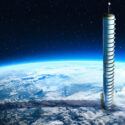Ah. The Sun. So bright. So hot. Time to jump into your super heat-resistant spaceship and get so close you could touch it. If you dare. How would you get to the Sun’s surface? What kind of temperatures would you encounter? And what materials could even protect you from this scorching heat?
The Sun is so massive that it accounts for 99.8% of our Solar System’s total mass. With a diameter of 1.4 million km (870,000), you could fit about one million Earths inside of it. It burns bright due to the process of nuclear fusion. Hydrogen atoms fuse to create helium and it’s worked that way for 4.5 billion years.
It’ll be another five billion years before it burns through all of its hydrogen. Then it will burn helium and will start to swell. Eventually it will swallow Mercury, Venus and the Earth. So you’d better touch it before it touches you. It’s time to head off on your journey to the Sun. Considering that big ball of gas has such a massive gravitational pull, it should be a pretty easy flight, right?
Well, this journey is going to be more of an odyssey. That’s because Earth is traveling almost entirely sideways relative to the Sun at a speed of about 108,000 km/h (67,000 mph). To get to the Sun, you’d need to cancel out that sideways motion. And that would require a lot of energy. About 55 times more energy than it takes to travel to Mars.
Like the Parker Solar Probe, your uber-ship is capable of speeds reaching 163 km/s (101 mps), but you’re still going to have plenty of time to prepare on the way. After three years you’d arrive at the Sun’s outermost layer, the corona. This layer is located 7 to 10 million km (4 to 6 million mi) above the Sun’s surface. And big surprise, it’s hot.
About 1 million °C (1.8 million °F). That’s almost 900 times hotter than lava. You’d also be exposed to massive amounts of radiation. Make sure you slather on copious amounts of specially formulated sunscreen that could shield you from everything from ultraviolet light to gamma rays. Without this, you could get radiation sickness leading to cancer, then death.
Not the most ideal kind of sunbathing, right? Obviously, you should wear sunglasses too. Or better, have a sunshield in your heat-resistant spacesuit. The Sun would be tens of thousands of times brighter here than it was back on Earth. Traveling onward, you’d reach the chromosphere. Now you’re 3,000 km (1,860 mi) above the Sun’s surface.
Surprisingly, temperatures here would take a big drop. In the chromosphere, they’d range from 3,700 to 7,700 °C (6,700 to 14,000 °F). And unlike other layers, it would get cooler as you get closer to the Sun. But look out. Massive loops of plasma could jet out toward you. These are solar prominences. And they are extremely hot. Plus, they could be ten times the diameter of Earth.
You’d now see how granulated the surface of the Sun looks up close. Below you would be bright expanses as wide as Texas surrounded by narrow, darker regions. Next stop, the photosphere. You’d have finally arrived at the surface of the Sun. As much as you’d like to land here, you couldn’t. That’s because the Sun has no actual surface.
It would be like stepping out onto a cloud. A scorching, searing cloud. The gravity would be so intense that if you weighed 70 kg (154 lb) back on Earth, you’d now weigh a whopping 1,800 kg (4,000 lb). Outside of your ship, that extra weight would crush your bones and organs. Ok.Pushing deeper from here, you’d enter the convective zone.
Temperatures would now hit 2 million °C (3.6 million ° F). That would be almost 400 times hotter than Earth’s core. The density here would be so intense even light would have a hard time escaping. A little bit like in a black hole. You’d be cooking in a soup of densely packed solar particles, blinded by their luminosity.
Finally, you’d make it to the core, 500,000 km (311,000 mi) below the surface. This is where the Sun’s nuclear fusion occurs. Ok.So what would happen now if you reached out to try and touch the Sun? This would be light-years beyond sizzling. You’d be almost instantly obliterated. A cremation furnace has temperatures of 1,000°C (1,800 °F) .
That wouldn’t even compare to the millions of degrees you’d encounter down here. And sorry to say there is no material on Earth that could withstand these temperatures enough for you to find out what the Sun really feels like. The closest we could get right now is about 1.6 million km (1 million mi)away. Probably should have mentioned that at the start.
Sources
- “Sun Facts: Interesting Facts About Sun (Or Sol)”. 2022. theplanets.org.
- “Parker Solar Probe Instruments”. 2022. nasa.gov.
- “It’s Surprisingly Hard To Go To The Sun”. 2018. nasa.gov.
- “Solar Flares”. 2022. hyperphysics.phy-astr.gsu.edu.
- “What If Humans Tried Landing On The Sun?”. Andrea Schmitz and Shira Polan. 2021. businessinsider.com.



























